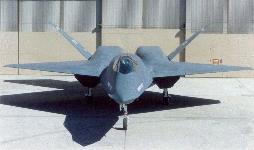The U.S. Army is in the early stages of developing the most expensive weapons program in its history, but the project could already be in jeopardy because it largely depends on three separate military programs that have been plagued by cost overruns, immature technologies and timetable delays.
At stake is what the Army calls its most ambitious modernization since World War II -- Future Combat Systems, a new generation of weapons, combat vehicles, robots and sensors connected to a wireless network. Imagine, for instance, a battlefield on which soldiers use remote-control devices to position hovering drones over an enemy encampment, then send those coordinates to a box of rockets that can launch and strike a moving target.
It's a costly vision: In the complicated math of the military, the Army said the program will cost $124 billion, or $162 billion including inflation. Independent estimates from the office of the Secretary of Defense price the project at $203 billion to $234 billion.
But none of those figures takes into account the expense of three complementary military programs that are supposed to serve as a critical communications network for Future Combat Systems. The three projects -- the development of high-speed radios, a wireless network and satellites -- are expected to be used by different parts of the military and cost about $80 billion combined, a figure that has risen by about $29 billion in recent years.
To read more of this content at The Washington Post, click here
Tuesday, April 8, 2008
Shuttle Extension Plan Won't Fly With Safety Group
Independent safety experts say it would be dangerous to fly NASA shuttles beyond 2010, and doing so could lengthen a five-year gap in the nation's ability to launch American astronauts, NASA warns.
But some argue the 6,400 job cuts projected for Kennedy Space Center could be reduced by flying shuttles twice a year until replacement rockets and spaceships are ready.
U.S. Reps. Dave Weldon and Tom Feeney say it could be done by giving NASA about $2 billion more a year to pay for the added shuttle flights and speed up development of spacecraft for missions to the moon and Mars.
To read more of this content at Space.Com, click here.
But some argue the 6,400 job cuts projected for Kennedy Space Center could be reduced by flying shuttles twice a year until replacement rockets and spaceships are ready.
U.S. Reps. Dave Weldon and Tom Feeney say it could be done by giving NASA about $2 billion more a year to pay for the added shuttle flights and speed up development of spacecraft for missions to the moon and Mars.
To read more of this content at Space.Com, click here.
Labels:
dave weldon,
NASA,
shuttle safety,
space shuttle,
tom feeney
Monday, April 7, 2008
Russian Rockets: Reliability Risks?
April 5, 2008: For the third time in two years, a Russian satellite launcher failed to put a foreign satellite into orbit. This time, it got the American AMC-14 satellite most of the way there, but left the bird 8,000 kilometers short of its 36,000 kilometer stationary orbit.
To read more of this content at The Strategy Page, click here.
To read more of this content at The Strategy Page, click here.
Lawsuit Against Lightning Gun Makers Moves Ahead
A law firm representing pissed-off investors in a lightning weapons maker scored what looks like an early victory in a lawsuit against the company. Scott+ Scott LLP announced that a judge rejected an attempt by the company formerly known as Ionatron to dismiss a class action lawsuit claiming officials in the firm knew their anti-IED lighting weapon was little more than jury-rigged mess:
To read more of this content at Wired's Danger Room, click here.
To read more of this content at Wired's Danger Room, click here.
Labels:
class-action lawsuit,
ionatron,
lightning gun,
scott and scott
Subscribe to:
Posts (Atom)









